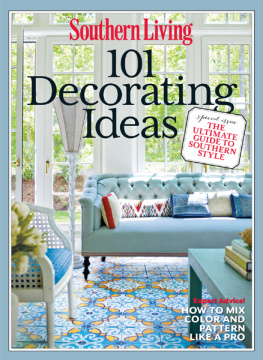To my inimitable style muse, my mother, Jin Hwa,
whose warmth and strength define true elegance,
and to my dear father, Sun, who lives up to
his name with a pioneering spirit that shines.
In a nutshell, my mantra for small space design is to delight, dazzle, and divert.
By my last count, Ive lived in twelve pocket-sized apartments over the past twenty yearsand not one of those personal spaces has measured more than 750 square feet. Its hard to forget the studio apartment where I could reach the refrigerator while sitting on my living room sofa, or the city rental where my guests would, more often than not, mistakenly toss their coats into the closetwhich was actually my bedroom!
I guess you could say that Im a serial small space nester with a unique vantage point. Each apartment Ive lived inwith its laundry list of lighting and structural flawshas become a personal decorating lab where Ive created and road-tested my ideas. Early on, I underestimated the importance of using wall anchors when hanging heavy objectsbecause I didnt use them, all my curtain rods fell down, along with chunks of drywall. Now, tension rods are my small space staple. That disaster motivated me to find solutions that are affordable, that I could do myself, and that wouldnt damage walls or windows permanently. Just as important to me is portability: I want to take the dcor with me when I move. Happily, these concepts have allowed me to live a little larger and more luxuriously within tight quarters, for with every mistake I made, there also came a breakthrough.
In a nutshell, my mantra for small space design is to delight, dazzle, and divert. First, delight your guests with design details so thoughtful, original, even outrageous, theyll hardly notice you live in a box. Next, dazzle them with flattering lighting, luxurious fabrics, and accessories that give off a bit of sparkle. Finally, divert any negative attention from the flaws of your space with whimsical decorative finishes.
These are the small space decorating principles that guide the projects youll find here. If you follow them, youll be able to impart a feeling of grandeur and glamour to any space regardless of its square footage. Even if you only have an hour, the simplest change can make a big style impact. The projects are ranked as quickies (1 hour or less), one-nighters (2 to 5 hours), or weekenders (6-plus hours) to help you gauge the time commitment involved.
My hope is that this book motivates you to adopt a less size-ist, less traditional attitude toward small space design: in other words, focus on what you can do, not what you cant. By experimenting with bold paint colors, unconventional materials and fabric, unexpected lighting, and innovative storage ideas, your space, no matter how vertically and horizontally challenged it is, will begin to reflect your personality and style. Venturing into new decorating territory can be daunting, but youre not alone. Just think of me as your design buddythe one whos happily made all the mistakes and done all of the footwork for you.
Flaunt Your Flaws
The room is so small, the mice are hunchbacked.
Henny Youngman, from Take My Life , Please! , 1992

Aime Herring, Janet Lee
Not able to leap tall buildings in a single bound? Short of acquiring superhero powers, transforming cramped quarters into a spacious and luxurious retreat is no easy feat. Throw in bad views, low lighting, and a popcorn stucco ceiling, and you have to ward off a trifecta of decorating villains.
How do you get back the power? By flaunting those flaws in unpredictable ways and reinventing eyesores into one-of-a-kind design attractions. Its the imperfections that will give your home a depth of personality and loads of character.
This chapter features bona fide living, breathing spaces that are short on square footage and long on their lists of inherited flaws. But once the decorating dust settled, through trial and error, the most clever and chic design remedies remained standing. They prove that sometimes in small spaces, you have to adopt a whole new design mantra. Flaunt it. Dont hide it.

Aime Herring, Janet Lee
Divide and Conquer Your Digs

It took some clever counterintuitive thinking to boost the style of this tiny 12-by-11-foot sleeping loft (with a 4-foot-tall ceiling) from claustrophobic to cozy. Dividing the loft into lots of little rooms or zones actually magnifies the feeling of expansiveness and dimension instead of shrinking the space. A reading nook, dressing area, bar lounge, and sleeping alcove make this nest look like a grand salon.

BEFORE
Aime Herring, Janet Lee

Aime Herring, Janet Lee
Look, theres more!
Contrasting paint, lighting, rugs, and art carve out stylish zones.
Bert the Turtle to the Rescue!

Watch your head! Measuring just 3 feet high, the entrance into this sleeping loft is potentially perilous with rows of low-hanging beams covered in stucco. Taking a cue from the Cold War era (extreme moments call for extreme measures), I downloaded and laminated a 1950s copy of Bert the Turtle, warning American children to duck and cover in case of an atomic attack. Now, thanks to Bert, a structural flaw is a cheeky design highlight.

Aime Herring, Janet Lee

BEFORE
Aime Herring, Janet Lee
Look, theres more!
Large-head screws and metal washers give this retro sign an industrial look.
Wallpaper Canopy

Stuck for ways to camouflage ugly beams? If you cant beat em, wallpaper em. Accentuate a not-so-positive ceiling beam with sophisticated wallpaper that dazzles. In this bedroom, stucco was stripped from one of the beams and patterned wallpaper extended up and over it. Now, the beam provides a chic canopy effect over the new bed and visually raises the eyeline of the ceiling. The canopy deflects attention from the remaining stucco-covered beams and turns a problem area into a knockout feature in the room!





















